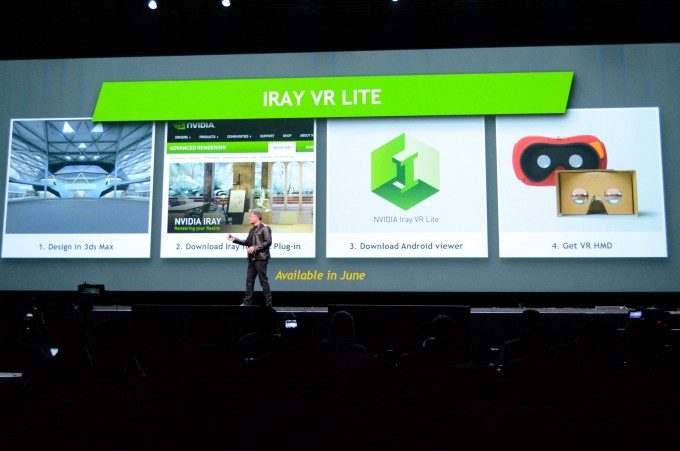NVIDIA at GTC 2016 today has announced Iray VR, a virtual reality adaptation of their Iray ray-tracing engine. The company says it enables “breakthrough photoreal”. On stage CEO Jen-Hsun Huang showed a quick demo of the rendering technology in action.
Iray is Nvidias’s physically-simulated rendering technology which can create photorealistic imagery.It works by simulating the physicla behavior of light and materials. Rendering such realistic frames takes very long and therefor cannot be done in real-time, let alone the blistering demand of 90 FPS from desktop-class VR headsets.
But Nvidia wanted to bring ray-traced photoreal visuals to VR, and so they created Iray VR, a new rendering plugin which renders such imagery in a way that’s compatible for virtual reality.
On stage, Nvidia CEO Jen-Hsun Huang explained that Iray VR works by creating light probes around the scene which render lightfields, volumetric areas that contain the information about the light traveling through that space. The system then chooses which probe to sample from based on the viewers location, and calculates what their view should be. This allows the viewer to see photoreal imagery in VR in real-time, according to Huang.
On stage, Huang picked up an HTC Vive headset and spun it around to show a view of the company’s not-yet-built future office rendered with Iray VR. From the demo it wasn’t clear that the system supported positional tracking, which would be a major limitation compared to a proper real-time rendering. We’ll go hands on with Iray VR here at GTC 2016 to learn more soon.
The company also revealed Iray VR Lite which is a similar ray tracing plugin for 3DS Max which renders ray-traced photospheres that can be viewed on mobile devices. Both Iray VR and Iray VR Lite will be available in June.







